 |
International Morse Code Radioman 3 & 2, Chapter 4 Bureau of Naval Personnel Navy Training Course NAVPERS 10228-E, 5th Edition, 1967 |
 |
International Morse Code Radioman 3 & 2, Chapter 4 Bureau of Naval Personnel Navy Training Course NAVPERS 10228-E, 5th Edition, 1967 |
[The material below is from a training manual used by U.S. Navy enlisted personnel studying for advancement to the rates of Radioman 3rd Class and Radioman 2nd Class (E4 and E5, respectively). This edition, dated 1967, was still around in the early 1970s when I used it. While it may provide a nostalgic look back for former Navy radio operators, much of the material on technique may still be useful for today's beginning amateur radio operators. Enjoy! -- WB3GCK]
The international Morse code is a telegraphic alphabet, with letters and numbers represented by sound patterns.
If you are a graduate of a Class A Radioman School, you were taught the Morse code, consequently much of this chapter may be of little interest to you. But, if this is your first acquaintance with the code - if you are striking for Radioman from the deck force, or changing to Radioman from another rating - you have many hours of hard work ahead. Do not be discouraged on this account. Many fine Radiomen learn the code for themselves.
The letters in Morse code are represented by dots and dashes; radio operators, however, substitute the expressions "dits" and "dahs," which closely resemble the sounds of the telegraphic hand key. The groups of dits and dahs representing each letter must be made as one unit, with a clear break between each dit and each dah, and a much more distinct break between the letters. A dit is one-third the length of a dah.
You must never try to count the dits and dahs. Do not let yourself get in the habit of doing so. It is a temptation at first, but you won't be able to count fast enough when the code speed picks up. Learn sound patterns instead. To understand what a sound pattern is, rap out the pattern beginning "Shave and a haircut." You recognize this from its characteristic rhythm, not because it has a certain number of beats in it. You must learn the code the same way. There are 36 Morse sound patterns for the letters and numbers, plus a few others representing prosigns and punctuation marks. With study and drill you can learn to recognize each pattern as fast as you now recognize "Shave and a haircut." The accent always falls on dahs, and you should pronounce each rhythmical combination with that emphasis in mind.
Go through the alphabet several times to get the sound "feel" of the dit and dah combinations.
In the pronunciation guide for sounds of letters that follows, sounds are written as phonetically as possible. In the middle of a group, the short sound "dit" actually takes on the sound "di." The phonetic alphabet is included in parentheses after the letters. Acquire the habit of referring to the letters phonetically.
Letter Pronunciation
A (ALFA) -------- di-DAH
B (BRAVO) ------- DAH-di-di-dit
C (CHARLIE) ----- DAH-di-DAH-dit
D (DELTA) ------- Dah-di-dit
E (ECHO) -------- dit
F (FOXTROT) ---- di-di-DAH-dit
G (GOLF) -------- DAH-DAH-dit
H (HOTEL) ------- di-di-di-dit
I (INDIA) -------- di- dit
J (JULIETT) ----- di-DAH-DAH-DAH
K (KILO) --------- DAH-di-DAH
L (LIMA) -------- di-DAH-di-dit
M (MIKE) -------- DAH-DAH
N (NOVEMBER) --- DAH-dit
0 (OSCAR) ------- DAH-DAH-DAH
P (PAPA) -------- di-DAH-DAH-dit
Q (QUEBEC) ----- DAH-DAH-di-DAH
R (ROMEO) ------ di-DAH-dit
S (SIERRA) ------ di-di-dit
T (TANGO) ------- DAH
U (UNIFORM) ----- di-di-DAH
V (VICTOR) ------ di-di-di-DAH
W (WHISKEY) ----- di-DAH-DAH
X (XRAY) -------- DAH-di-di-DAH
Y (YANKEE) ----- DAH-di-DAH-DAH
Z (ZULU) -------- DAH-DAH-di-dit
Number Pronunciation
1---------------- di-DAH-DAH-DAH-DAH
2---------------- di-di-DAH-DAH-DAH
3---------------- di-di-di-DAH-DAH
4---------------- di-di-di-di-DAH
5---------------- di-di-di-di-dit
6---------------- DAH-di-di-di-dit
7---------------- DAH-DAH-di-di-dit
8---------------- DAH-DAH-DAH-di-dit
9---------------- DAH-DAH-DAH-DAH-dit
0---------------- DAH-DAH-DAH-DAH-DAH
Punctuation Mark Pronunciation
Hyphen (dash) ---- DAH-di-di-di-di-DAH
Parenthesis L ---- DAH-di-DAH-DAH-di-DAH
R ---- DAH-di-DAH-DAH-dit
Point ----------- di-DAH-di-DAH-di-DAH
Slant ------------ DAH-di-di-DAH-dit
Apostrophe ------- di-DAH-DAH-DAH-DAH-dit
Colon ------------ DAH-DAH-DAH-di-di-dit
Comma ---------- DAH-DAH-di-di-DAH-DAH
Question mark ---- di-di-DAH-DAH-di-dit
If you have any trouble learning Morse code, the following method may be helpful. Go through the three groupings of short, medium and long sounds with their accompanying practice words. Make up words of your own if you wish to give yourself further practice. Speak the practice words in code. Say "tee: DAH dit dit;" "mine: DAH-DAH di-dit DAH-dit dit."
If you can speak words in code rapidly and distinctly, you will have an easier time when you learn to receive code on the receiver. The sounds are very similar.
You probably have noticed by now how numerals slow your speech in oral transmission. That is understandable - they also slow the speed of radio transmission. Headings containing procedure signs, calls, and numerals are transmitted at a slower rate of speed than straight alphabetical characters.
Short sounds Practice words
E dit TEE ATE EAT TEA MEAT
T dah MEET MINE TIME MAINE
A di-DAH TEAM AIM NITE TAME TEA
I di-dit MATE TAME NAME MITE
M DAH-DAH MIAMI MAMA MEAN MAN MAT
N DAH-dit EMIT MINT MANE TAN ITEM TINT
Medium length sounds Practice words
D DAH-di-dit MUST SAME MAMA SUIT AUTO
G DAH- DAH- dit MUSS OUST MUSE MUTE ATOM
K DAH-di-DAH TAUT MAST MASS SUET SAM
0 DAH-DAH-DAH WIND SEA TUM SAW OAT
R di-DAH-dit SUE SAT WED SUM MUD IOU
S di-di-dit USE SEAM WOOD DARK
U di-di-DAH GEORGE DOWN KIND SORT
W di-DAH-DAH DOOR MASK WORK GROW
WOMAN EDGE GAGE
WIGS WORM WAGER
WAKE KEG
Long sounds Practice words
B DAH-di-di-dit VAT VET VIM HAM SIX
C DAH-di-DAH-dit SAY
F di-di-DAH-dit HAS HAT EVE CUT
H di-di-di-dit CAM VEST
J di-DAH-DAH-DAH HEAT HAVE MUCH
L di-DAH-di-dit THAT EACH
P di-DAH-DAH-dit COAT ACHE SAVE HUSH
Q DAH-DAH-di-DAH ACME
V di-di-di-DAH CUTE BAKER CHARLIE
X DAH-di-di-DAH FIVE
Y DAH-di-DAH-DAH HOW JIMMY LIKE
Z DAH-DAH-di-dit PAPA QUICK QUILL
VICTORY XRAY YOUNG
ZERO BUZZ GARGLE
FIZZLE LYNX OXYGEN
WAX QUAY JERKY WHIP
QUEBEC
Figure sounds
1. di-DAH-DAH-DAH-DAH
2. di-di-DAH-DAH-DAH
3. di-di-di-DAH-DAH
4. di-di-di-di-DAH
5. di-di-di-di-dit
6. DAH-di-di-di-dit
7. DAH-DAH-di-di-dit
8. DAH-DAH-DAH-di-dit
9. DAH-DAH-DAH-DAH-dit
0. DAH-DAH-DAH-DAH-DAH
If you have carried out the recommendations made up to this point, you are ready to receive code transmitted to you on an oscillator. The ship or station to which you are attached is almost certain to have practice oscillators for your use.
An experienced Radioman will key code groups to you for your training. The sound produced by an oscillator closely resembles the sound of code from the radio receiver. The operator keying to you for practice should transmit each individual character at the standard rate of 20 words per minute. He should maintain a fairly long interval between characters. As you progress, you gain speed by shortening spaces between characters.
The standard character speed is shown in figure 4-1. Note that the characters themselves may be keyed at 20 words per minute, but that the longer intervals between characters and words materially decrease the beginner's overall speed. Note also that the code, compared against time in the 20-words-per-minute transmission, is in the proper form of having the dit as a unit. There is one unit between each element of a character, three units between each character, and seven units between each group or word.
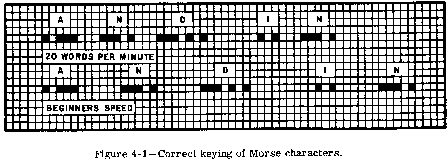
After learning the sound of each character at this rate of speed, it is not difficult to reduce the time between characters and to copy code at a much faster speed.
As you advance in rating, you will be required to increase your transmission and reception speed. If you learn the fundamentals well, it will be fairly easy for you to increase your speed. When copying code, if you miss a character, don't stop to worry about it; get the next character and let the one missed go by. Be a competent operator. Make every transmission and every reception accurately. Do not place speed before accuracy.
Learn to print clearly and rapidly. The messages you handle are important, and someone must read what you have written without puzzling over it. Examine figure 4-2 and compare the printed letters with your own. Notice that the sequence of strokes for some letters may be different from the way you customarily form them. As an aid to rapid printing, the more of the letter you can form with a single stroke, the better. Use this illustration as a guide to avoid confusions between printed letters and printed numerals. Especially watch the letter Z and the numeral 2. If you wish, write Z with a line through the stem (-Z). Even more important is the distinction between the capital letter O and the figure zero. In communication work, zero is always written with a slant through it (Ø). Exercise care to avoid confusion between letter I and figure 1, and also letter S and figure 5.
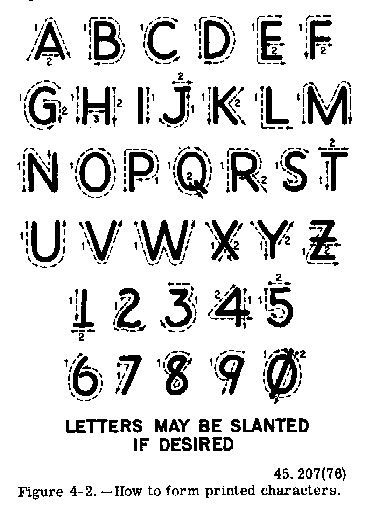
As your code speed increases, you will find it impossible to print rapidly enough to keep up; therefore, typewriting is a skill also required of all Radiomen. Use of a good commercial text can help you master touch-typing. A typing course for beginners also is offered by USAFI.
Your ability to send well depends mainly upon two capabilities. First, you must know the correct sound of the character you are attempting to transmit. Second, you must know the proper method for keying with perfect control. Practicing the code aloud, as well as receiving it by oscillator, has given you a good knowledge of code sound. The proper method for keying is your next concern.
The first key you will use is the hand key. The hand key is widely used on radiotelegraph circuits and with practice oscillators. It must be adjusted properly before you can send clearcut characters. Figure 4-3 shows a hand key, with parts labeled.
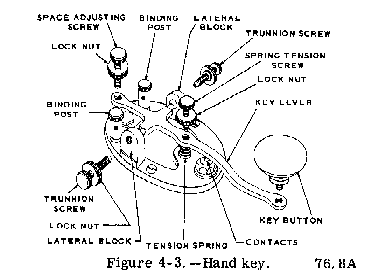
The spring tension screw, behind the key button, controls the amount of upward tension on the key. The tension desired varies with operators. Too much tension forces the key button up before the dahs are completely formed; spacing between characters is irregular, and dits are not clearly defined. If the spring tension is very weak, characters run together and the space between characters is too short.
The gap between the contacts, regulated by the space adjusting screw at the back of the key, should be set at one-sixteenth inch for beginners. This measurement does not apply to every key and operator; it is a matter of personal preference. Some operators like a closed key, others an open key. "Closed" and "open" are terms for a short and a long gap. As the student progresses, further gap adjustment may be made to suit his sending speed. Contacts that are too close have an effect similar to weak spring tension. Contacts that are spaced too far have the same effect as too much spring tension.
The final adjustment of the key is the sidewise alignment of the contact points. This alignment is controlled by the trunnion screws at either side of the key. If they are too tight, the key lever binds. If they are too loose, the contacts have sidewise play. Usually, when the sidewise alignment is correct, no further adjustment is required.
Learn from the beginning the correct way to grasp the key. Do not hold the key tightly, but let your fingers rest lightly on the key knob. Your thumb rests against the side, your forefinger rests on top of the key, your other fingers are bent slightly in a relaxed position. Check figures 4-4 and 4-5 for the correct method of keying. To ensure correct movement of your wrist and forearm, your arm should lie on the operating desk. The muscle of your forearm - not your elbow - should support the weight of your arm. Your elbow should not extend over the edge of the table, because the pressure of the underside of your forearm will partly block circulation and tire you. Sit upright, with your arm in line with the key.
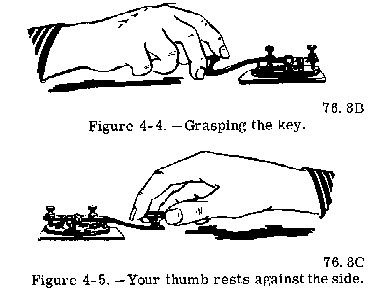
Your ability to transmit depends to a great extent on acquiring the proper movements of your wrist and hand while operating the key. To close the key, your wrist moves upward and your hand rocks downward toward your fingertips. To open the key, these two movements are reversed- your wrist comes down and your hand rocks back.
Make your wrist flexible. Limber it up. Correct wrist action may be developed by moving your wrist up and down like a hinge. Another exercise is rotating your hand in clockwise circles, with your wrist held in a stationary position. These exercises will relieve any undue tension you may experience when first beginning to transmit.
The semiautomatic key, also known as the bug or speed key, is used chiefly when operators are required to send for relatively long periods of time. It is designed to make sending easy instead of fast. Hence, perfect control of the key is far more important than speed.
In sending with the bug, the thumb presses
the dit paddle (fig. 4-6) to the right, and the
index finger forms dahs by pressing the knob
to the left. The key sends successive dits when
the paddle is held to the right. One dit or a
series may be sent, depending on how long the
thumb pressure is maintained against the paddle.
One dah is formed every time the knob is pressed
to the left. Dahs must be sent individually. While sending, the hand pivots at the wrist; the hand and arm motion is horizontal.
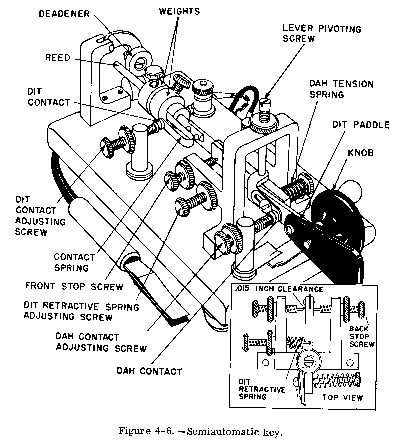
Best operation of the semiautomatic key is obtained when it is adjusted to send dits and spaces of equal length. Adjust the key as follows, locating the parts in figure 4-6 when adjusting the key:
If the adjustment instructions are followed carefully, the bug makes 25 or more dits before stopping. The first 12 to 15 dits will be practically perfect, with the dits and spaces equal.
Good operators have sending rhythm, and you can acquire it in just one way: by practice.
It may be difficult for you to key correctly at first, because your wrist is unfamiliar with the type of movement required for sending telegraphic code. Your wrist will be stiff, and you'll have to get rid of that stiffness by a lot of practice. Don't favor the stiffness of your wrist. If you do, your sending will be choppy.
The following exercises have been prepared carefully. Use them as an instruction guide.
Try these practice groups several times, backward and forward. Make them clearly and distinctly, spending more time on characters that cause you any trouble.
MEET EMIT MITE ITEM
MINED UNITED READY MAUDE TEAMED
DOOM MOST ROAD MOTOR WORST MOTION
WOKE ANCHOR DOMO
SOB BASSINET BIND BESTED BEAUTY
SNOB BABBITT BURST
Practice the remaining letters of the alphabet and the numerals. When you think you're ready for it, practice the code exercises that follow.
1. E E E T T T A A A N N N I I I S S S H H H
M M M O O O E E E T T T A A A N N
I I I S S S H H H M M M O 0 0 E E E T T T
I I I M M M A A A N N N S S S O 0 0 H H H
E E E T T T E E E T T T I I I M M M I I I
M M M A A A N N N A A A N N N S S S
O O O S S S
2. U U U V V V D D D B B B K K K C C C
W W W J J J P P P U U U V V V D D D
B B B K K K C C C W W W J J J P P P
W W W J J J P P P U U U V V V K K K
C C C B B B D D D U U U D D D V V V
B B B P P P J J J C C C K K K W W W
D D D B B B V V V U U U W W W J J J
3. R R R L L L F F F G G G Z Z Z X X X
Y Y Y Q Q Q R R R L L L F F F G G G
Z Z Z X X X Y Y Y Q Q Q G G G Z Z Z
F F F L L L R R R Y Y Y Q Q Q R R R
X X X Z Z Z R R R F F F L L L Q Q Q
Y Y Y G G G Q Q Q Y Y Y R R R
4. 1 1 1 2 2 2 3 3 3 4 4 4 5 5 5 6 6 6 7 7 7 8 8 8
9 9 9 � � � 1 1 1 2 2 2 3 3 3 4 4 4 5 5 5 6 6 6
7 7 7 8 8 8 9 9 9 � � � 1 1 1 2 2 3 3 4 4 5 5
6 6 7 7 8 8 9 9 � � 1 1 2 2 3 3 4 4 5 5 6 6 7 7
8 8 9 9 � � 1 2 3 4 5 6 7 8 9 � 1 2 3 4 5 6 7
8 9 1 2 3 4 5 6
5. V U I Y Q Z C X G R S L K J P Q X Z R I
F C V B W F K D S H Q Z A L K F B V R
S T U O T M E G Y Z X V E G N I W S L H
M U A E V U A E W Q G H V C I X Z L N
R Y U K V U
6. E 8 Y 7 B 6 X 1 W � Z 2 A 3 C 5 S 4 1 2 F
U 1 F 5 D 8 Q 4 T 6 U 9 Q 2 E � S 5 U l Y
G 2 J 4 S 3 E 5 T 7 Z 8 K 6 M 9 R l A 2 R
S 7 W B E 9 R 2 A 3 Z 3 X 6 U 8 B 7 C 6 T
7. MI AN SY NL TY CE DO PS CX ZW QA PK
LN HU WC VN BM ZS CD QA IU SD LM UH
GY TR DC VT AR YU FD SA IG WQ XT ZI
NY OT ED BM LP YU GH BY RE DF LS
WQ XS ZI TY BG NH JV KL MD MI AN SY
NL TY CE DO PS
8. EF TS 16 29 83 ZJ 45 �7 WR ND KW IC UX
91 �2 1B LO FG 84 63 XW AC TM SU 5� 72
XR RJ ZM 43 65 VH 97 LM 12 46 7� FC FE
EY 34 56 27 FT FY JU IT 98 76 75 52 DE
WE QT 13 36 57 KF RI YT 19 93 35 41 FK
YU 96 �1 MC AR TH 19 25 3� UR BO UL
32 �5 21
9. NDT EGH RTS LYB FCC ZEX PIH CWE
LKJ QIE NUG CVT EPL SZW QAU SH
GBT VRT GIK GYO DCM XSD ZAU YER
DLN URG HNB VDX ZWS QTA GHI PT
MBY PLK RDC ESX IUP PKJ NYH GHT
DFR VED SWN VBT XFZ RDA SEN FU
GBC YRF DSE WNJ GVA SWQ QIX ZOT
MEH GKD BGV CFI ATA RUR SAC LT
NVR DAB BLM INY EGB LKO MWD SKZ
QLD YGB NDT EGH RRS FLM FCC ME
10. OVLH MYBL URXO HIZO VICT
FINX SCXS HTYV IQNT UBML
ABLB EJLN CYZB ZWCN JNDZ
UTLZ KLAB DEFZ VNUW KFRE
11. JICOY TXSTY 38�95 RDIHA
JXTDZ OXYDW XPZSY RSPHD
89706 CUSPI RNBRJ 65289 ZONIG
FYEQU ARQNV RNLPT KAKOZ
8784� BVGAN WKOQT SRQMT
UJVWN 45872 YXBCX AFKOZ
OGLCT NIHGP 12349 ATUSK
SLEWQ
12. OLMX MVNH UWQR NVUT KUXF
CDEH LYHE DIPA ZQWI AYSK
QIQA WMNW ZIHZ CAKD BTGW
WNLI PWBU OXAD XFRJ IQCA
13. ZMJXI URYNC 9347� PQAZM
DEGVM NCBVG HUGHY 13267
PHRAN QUECC 1289� MCNDH
EUIRY WQAZX IRSVZ MCURI
72439 OYTRW PIQAW CNJWO
OWQAJ OISKM 1�7�6 DGFHG
KSBOU
14. UTHA VNCB RFDS EDCD CXVD
RWQI MNJF STRO TNBL UJHK
NIOQ JUYR GBNX VCXT RJTU
BCDV CGFH 5781 JGVX HGJD
Continue sending to yourself with the practice key and oscillator. If you can operate with another striker, so much the better. Sit down at an unused operating position and tune in some slow code. It is not hard to find, especially on amateur frequencies. Copy as best you can. Don't worry too much about missing letters. Get what you can, no matter how little it is. As your speed picks up, tune in faster code. If you find you are copying a certain speed solidly, the code is too slow. Keep it faster than you can copy comfortably.
You will need lots of practice. Class A Radioman Schools ashore run a full day, and for months a man copies code several hours daily. Make the transition from pencil copying to the typewriter as soon as possible.
As you gain skill, try copying the 18-wpm to 20-wpm fleet broadcasts. Devote as much time as possible-15 or 20 hours per week-not just an hour now and then. Do not be afraid to use some of your off-duty time. Simultaneously, begin to learn how to hold down a circuit. One of the best ways to do this is to spend several watches logging circuits that other operators are manning. At the end of every watch, compare your log with that of the regular operator, and question him about anything you do not understand. That way you see procedure in use and gain practice in copying many fists.
Learn to copy behind. If you are recording B as D, S as I, J as W, and so on, you are copying too close. The farther behind the better. At first, listen to one character while setting down the previous one. Try to fall back one letter more. Listen for the character while carrying one in your head and setting down the one before that. Once you have the knack, you will find copying behind is easier, faster, and more accurate. The faster the code, the farther, you must stay behind. Watch an oldtimer copy press at 35 or 40 wpm. You will find he is carrying anywhere from 5 words to a sentence in his head.
One further word of advice: It is common for a student learning code to hit a plateau. The regular progress to higher speeds stops, and for a time the student finds himself unable to copy faster than a certain speed. If this happens to you, just stay with it until your speed picks up. Never lose confidence in the knowledge that any may of ordinary ability can learn the code if he puts in the necessary time and work.